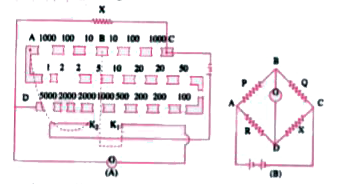A converging lens of focal length 12 cm and a diverging mirror of focal length 7.5 cm are placed 5.0 cm apart with their principal axes coinciding. Where should an object be placed so that its image falls on itself?
30 cm from the lens further away from the mirror
Topper's Solved these Questions
- RAY OPTICSBOOK - AAKASH SERIESCHAPTER - RAY OPTICSEXERCISE - PROBLEMS ( LEVEL-I)
37 Videos
- PRACTICAL PHYSICSBOOK - AAKASH SERIESCHAPTER - PRACTICAL PHYSICSEXERCISE - LECTURE SHEET LEVEL-II (ADVANCED) Linked Comprehension Type Questions
6 Videos
- SEMICONDUCTOR DEVICESBOOK - AAKASH SERIESCHAPTER - SEMICONDUCTOR DEVICESEXERCISE - EXERCISE - II
31 Videos
Similar Questions
The magnetic field in a plane electromagnetic wave is given by B.=(2×10−7T)sin[500x+1.5×1011t]
What is the wavelength and frequency of the wave?
View SolutionPassage :
Post office is useful to measure the value of unknown resistance correctly upto 2nd decimal place. It is based on Wheatstone bridge.

Systematic diagrams of post office box are shown in the above figures. Each of the arms AB and BC contains three resistance of 10Ω,100Ωand1000Ω. These arms are generally known as ratio arms. With the help of these resistance, we can introduce resistance P in arm AB and Resistance Q in arm BC. The resistance arm AD is complete resistance box containing resistance from 1Ωto5000Ω. In this arm, we can introduced resistance R by taking out plugs of suitable values. The unknown resistance X is connected in fourth arm CD. These four arms actually form Wheatstone bridge shown in figure. For balanced conditions, no deflection is formed in galvanometer. At balanced condition PX=QR,X=QRP
What is the minimum and maximum possible resistance, which can be determined by using post office box?
View SolutionA full-wave p-n diode rectifier uses a load resistor of 1500Ω. No filter is used. The forward bias resistance of the diode is 10Ω. The efficiency of the rectifier is
View SolutionA diverging lens of focal length 12 cm and a converging mirror of focal length 10 cm are placed coaxially at a separation of 5 cm. Where should an object be placed so that a real image is formed at the object itself ?
View SolutionA converging lens of focal length 15 cm and a converging mirror of focal length 10 cm are placed 50 cm apart. If a pin of length 2.0 cm is placed 30 cm from the lens farther away from the mirror, where will the final image form and what will be the size of the final image ?
View SolutionA diverging lens of focal length 20 cm and a converging lens of focal length 30 cm are placed 15 cm apart with their principal axes coinciding. Where should an object be placed on the principal axis so that its image formed at infinity ?
View SolutionA diverging lens with magnitude of focal length 25cm is placed at a distance of 15cm from a converging lens of magnitude of focal length 20cm. A beam of parallel light falls on the diverging lens. The final image formed is.
View Solution(a) A point source S is placed at a distance of 15 cm from a converging lens of focal length 10 cm on its principal axis, where should a diverging mirror of focal length 12 cm be placed so that a real image is formed on the source itself?
(b) A diverging lens of focal length 20 cm and a converging mirror of focal length 10 cm are placed coaxially at separation of 5 cm. Where should an object be placed so that a real image is formed at the object itself?
(c) A converging lens of focal length 12 cm and a diverging mirror of focal length 7.5 cm are placed 5.0 cm apart with the principal axis coinciding where should an object be placed so that its image falls on itself?
View SolutionA diverging lens of focal length 20 cm is placed coaxially 5 cm toward left of a converging mirror of focal length 10 cm. Where would an object be placed toward left of the lens so that a real image is formed on object itself.
View SolutionA point source S is placed at distance of 15 cm from a converging lens of focal length 10 cm . Where should a (i) concave mirror (ii) convex mirror of focal length 12 cm be placed so that real image is formed on object itself.
View Solutionएक अभिसारी लेंस जिसकी फोकस दूरी 12 cm हैं तथा एक अपसारी दर्पण जिसकी फोकस दूरी 10 cm हैं , समाक्षीय रुप से 5.0 cm दूरी पर रखे गए है । एक वस्तु को कहाँ रखा जाए ताकि उसका प्रतिबिंब वस्तु पर ही बने ?
View SolutionThe focal length of a concave mirror is 12 cm . Where should an object of length 4 cm be placed so that a real image of 1 cm length is formed ?
View SolutionA diverging lens with magnitude of focal length 25 cm is placed at a distance of 15 cm from a converging lens of magnitude of focal length 20 cm. A beam of parallel light falls on the diverging lens. The final image formed is
View SolutionA diverging lens of focal length 20 cm and a converging mirror of focal length 10 cm are placed coaxially at a separation of 5 cm. Where should an object be placed so that a real image is formed at the object itself ?
View SolutionA diverging lens of focal length 20 cm and a converging lens of focal length 30 cm are placed 15 cm apart with their principal axes coinciding. Where should an object be placed on the principal axis so that its image formed at infinity ?
View SolutionA diverging lens with magnitude of focal length 25 cm is placed at a distance of 15 cm from a converging lens of magnitude of focal length 20 cm . A beam of parallel light falls on the diverging lens. The final image formed is.
View Solution

